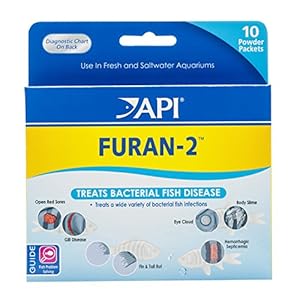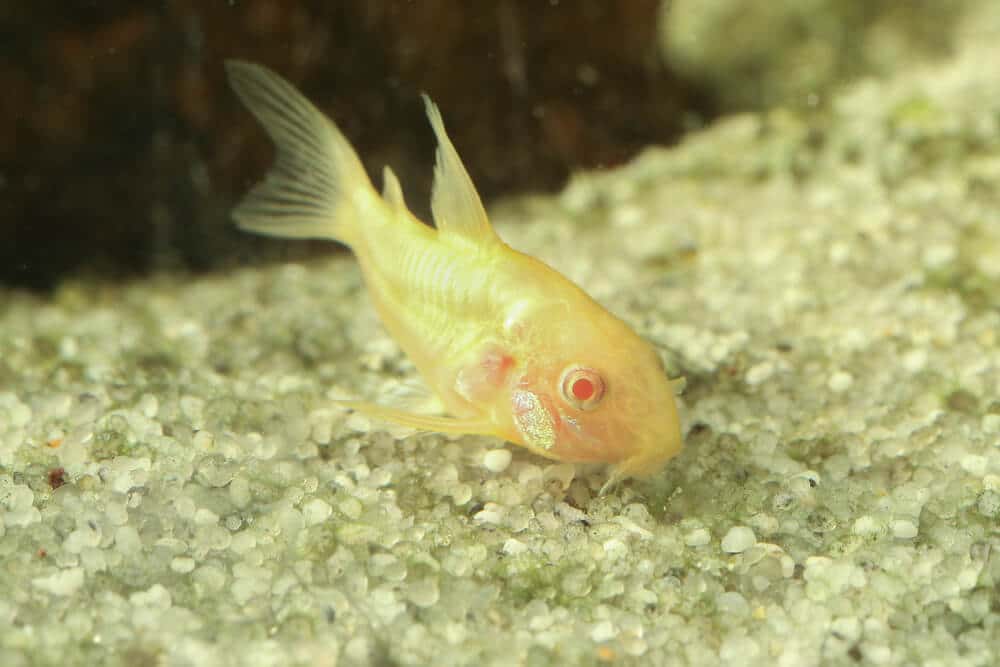Did you see fungus-like growth on your Cory Catfish? Then read on till the end to learn why it happens (is it really due to fungus or something else) and how you can cure it.
Why Does My Cory Catfish Have White Fungus?
The most likely cause of a cory catfish having white fungus is the columnaris or cotton wool disease. However, depending on the specific symptoms, it can also be an actual fungal disease or a white spot parasitic disease.

True fungal infection is less likely to occur in fish than bacterial or parasitic infection. Let’s see one by one each type of possible infection.
#1. Columnaris or Cotton Wool Disease (Bacterial)
Caused By: Flavobacterium Columnare
Columnaris or Cotton Wool Disease is often misunderstood as a fungal infection. But actually, it is a bacterial disease caused by the bacteria “Flavobacterium columnare.”
The columnaris disease is mainly found in fish that have compromised immune systems.
When viewed under a microscope, the bacteria causing the columnaris disease look like rods or columns – hence, the bacteria received the name.
Signs:
Here are some of the signs that indicate the presence of Columnaris disease in cory catfish
- The appearance of cottony-looking lesions on the mouth of fish.
- Off-Colored patches on the fish body. The color of the infection is usually white but can also look orange or yellow.
- The patches on the fish are initially flat but can appear fuzzy with the progress of the disease – and this is the point where it is often misunderstood as a fungal infection.
- As the infection progresses, it can completely eat away the scales and fins of the fish.
- The underneath fish muscles are sometimes revealed as the infection continues to eat through their skin.
- Although rare, the infection is also noticed behind the fish’s dorsal fin as a round patch. And that looks like the fish is wearing a small horse saddle. So that is why columnaris is also referred to as Saddleback disease.
Columnaris is a fatal disease if left untreated and also quite contagious among fish.
Unfortunately, this disease is so dangerous that the fish may not make it past one or two days from the appearance of the first sign.
So it is essential to take action and apply treatment as soon as you notice the signs.
Treatment:
The first step in treating columnaris in your cory catfish is quarantining it in a separate tank. Doing this will prevent infection from spreading to other tank mates. Also, it will protect the sick cory catfish from being bullied by other healthy tank mates.
Next, ensure the water parameters remain suitable for treating sick fish.
Then, you need to ensure the temperature of the tank is suitable. Columnaris prefers heat, so you must lower the tank temperature to around 75 °F (24 °C) because, in warmer water, columnaris spreads faster.
Finally, start dosing the sick fish with a combination of nitrofurazone and Kanamycin.

For nitrofurazone-containing medication, you can check this medication from API (Available on Amazon)

And for Kanamycin-containing medication, you can go with Kanaplex medication from Seachem (available on Amazon).
Salt might help sometimes. It decreases the osmotic stress the fish has to go through because of the damage to their epithelium by bacteria. However, salt treatment should be avoided on scaleless fish like corydoras catfish (because scaleless fish don’t tend to tolerate much salt).
#2. Ich Or White Spot Disease (Parasitic)
Caused By: Ichthyophthirius multifiliis (a protozoan parasite)
A very common parasitic disease occurs that in aquatic fish known as Ich or white spot disease.
Since you have come up here searching for fungal disease, in most cases, your cory catfish won’t be suffering from it.
But still, it is good to be sure that it is Ich or something else.
Signs:
Here are some helpful signs to identify whether your cory is suffering from Ich:
- Just like the name of the disease, you’ll notice small white spots on your fish’s body or fins.
- With the progress of the disease, fish become irritated.
- The fish rubs against the sides and bottom of the tank.
- Loss of appetite and respiratory distress.
If these symptoms match with your cory catfish, then the Ich is the root cause of the problem.
Treatment:
Luckily, fish don’t die quickly from Ich disease (provided they don’t have a compromised immune system). And it is one of the easiest diseases to treat.
There are different ways to treat Ich in fish.
- Using Aquarium Safe Ich Medications
- Using the Heat Curing Method
- Using Aquarium Salt
If you are a beginner in fishkeeping, the best and an effective option is to choose an aquarium-safe Ich medication for treatment.

You can get medication like API Liquid Super Ick Cure (available on Amazon) to treat Ich or white spot disease in the fish.
Here’s a video that explains how you can treat Ich in fish:
If you are interested in the other two methods of treating Ich – the heat curing method and the salt curing method, please refer to my guide: Can Fish Survive Ich Without Treatment?
#3. True Fungal Disease
Caused By: Saprolegnia, Achlya, and Fusarium (Different Species of Fungus)
You noticed that your cory catfish has fungus-like outgrowth. And you have ruled out the chances of being Columnaris or Ich; it is ultimately an actual fungal infection.
There are many different fungal species that cause the infection in fish like Saprolegnia, and others.
Signs:
Here are some possible signs to look for when your cory catfish is infected with a fungal infection:
- The appearance of white or gray spots on the skin.
- Furry growth along the gills and mouth of the fish.
- Bumps on the body of the fish that don’t bleed.
- Fish swimming erratically and clamped fins.
Treatment:
For treating true fungal infections, you can use Maracyn Oxy by Fritz Aquatics (available on Amazon). This product is made for true fungal infections on fish and relieves your fish from those infections.
It is a non-antibiotic solution treatment that helps control fungal infections from Saprolegnia, egg fungus, Ichthyosporidium, and related species.
The general rule for dosing is to use 1/2 capful per 10 gallons of water. If you have small tanks, you can follow the general direction of 5 drops per gallon. You can continue this dosage as per the requirement for up to 5 days.
Read Related: Why Is My Cory Catfish Turning White?
How To Identify Whether It Is A Fungal Infection Or Columnaris?
Sometimes it can become hard to identify a true fungal infection in your cory catfish from the columnaris disease.
Fungal Infection:
- The appearance of white fuzz – like a bread mold.
- White or Gray infection color.
Columnaris (Bacterial Infection):
- Initially, flat and pale patches on the body but with infection progress, the appearance is fuzzy.
- The infection color can be white, yellow, or orange based on the strain.
Here’s a video to understand more about the difference between Fish Columnaris and the fungal infection:
Final Thoughts
In short, if your cory catfish has white fungus, it can be either a true fungal infection, a white spot parasitic disease, or a columnaris bacterial infection.
Understanding the infection correctly and applying the treatment is the key to ensuring your cory catfish is happy and lively again!
Recommended Read: Do Cory Catfish Need Bubblers In Their Tank?
Hi! I’m Praveen Ghoshal, the founder of eFishkeeping.com. Inspired by my Dad, I got interested in fishkeeping when I was a kid. Since then, I have been involved with this hobby. Currently, I have 3 fish tanks at our home, and I enjoy this hobby with my full family. Read more about me here.





![Do Neon Tetras Die Easily? [Here’s The Truth!] do-neon-tetras-die-easily](https://efishkeeping.com/wp-content/uploads/2023/03/do-neon-tetras-die-easily-300x200.jpg)


